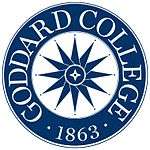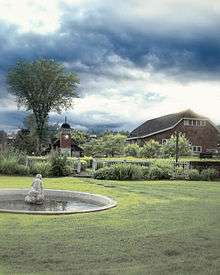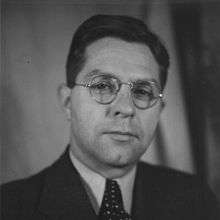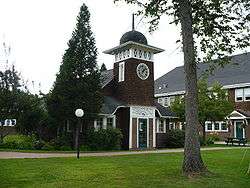Goddard College
 | |
Former names | Green Mountain Central Institute & Goddard Seminary |
|---|---|
| Type | Private coeducational Low Residency |
| Established | 1863 |
| President | Robert P. Kenny |
Academic staff | 110 |
Administrative staff | 90 |
| Students | 700 |
| Undergraduates | 235 |
| Postgraduates | 465 |
| Location | Plainfield, Vermont, United States |
| Campus | Rural 175 acres (71 ha) |
| Colors | Blue and white |
| Website |
www |
 | |

Goddard College is an accredited private liberal arts college located in Plainfield, Vermont, Port Townsend, Washington, and Seattle, Washington, offering undergraduate and graduate degree programs. With predecessor institutions dating to 1863, Goddard College was founded in 1938 as an experimental and non-traditional educational institution based on the ideas of John Dewey: that experience and education are intricately linked.[1]
Goddard College currently operates on an intensive low-residency model. Each student designs his/her own curriculum; the college currently uses a student self-directed, mentored system in which faculty issue narrative evaluations of student’s progress instead of grades. The intensive low-residency model requires students to come to campus every six months for approximately eight days, during which time students engage in a variety of activities and lectures from early morning until late in the evening, and create detailed study plans. During the semester students study independently, sending in "packets" to their faculty mentors every three weeks. The content of the packets varies with each individual, but focuses on research, writing, and reflection related to each student's individualized study plan.
Goddard offers a Bachelor of Arts (BA), Bachelor of Fine Arts (BFA), Master of Arts (MA), Master of Fine Arts (MFA), along with several concentrations and Licensures. Goddard currently enrolls approximately 700 students, 30% of whom are undergraduates, and employs 110 faculty and 90 staff.
Mission
To advance cultures of rigorous inquiry, collaboration, and lifelong learning, where individuals take imaginative and responsible action in the world.
History
Goddard College began in 1863 in Barre, Vermont, as the Green Mountain Central Institute and in 1870 was renamed Goddard Seminary. Founded by Universalists, Goddard Seminary was a four-year preparatory high school, primarily for Tufts College. For many years the Seminary prospered. But the opening of many good public high schools made many of the New England academies obsolete. To attempt a rescue, the trustees added a Junior College to the Seminary in 1935, with a Seminary graduate, Royce S. "Tim" Pitkin, as President.[2]

Royce S. "Tim" Pitkin was a progressive educator and follower of John Dewey, William Heard Kilpatrick and other, similar proponents of educational democracy. In 1936, under his leadership, the Seminary came to the conclusion that in order for Goddard to survive an entirely new institution would need to be created. A number of prominent educators and laymen agreed with him. Pitkin was supported by Stanley C. Wilson, ex-governor of Vermont and chairman of the Goddard Seminary Board of Trustees; Senators George Aiken and Ralph Flanders and Dorothy Canfield Fisher.[3] Pitkin was able to persuade the Board of Trustees to embrace a new style of education, one that substituted individual attention, democracy, and informality for the traditionally austere and autocratic educational model. On March 13, 1938, Goddard College was chartered. In July 1938 the newly formed Goddard College moved to Greatwood Farm in Plainfield, Vermont.
The new Goddard was an experimental and progressive college. For its first 21 years of operation, Goddard was unaccredited and small, but built a reputation as one of the most innovative colleges in the country.[4] Especially noted were Goddard’s use of discussion as the basic method in classroom teaching; its emphasis on the whole lives of students in determining personal curricula; its incorporation of practical work into the life of every student; and its development of the college as a self-governing learning community in which everyone had a voice.[5] In 1959 Goddard College was accredited. As of 2015 it is accredited by the New England Association of Schools and Colleges.[6]
One of the founding principles upon which Goddard was founded was that the College should provide educational opportunities for adults.[7] It became clear that there was a great need for a program through which adults who had not completed college could obtain degrees without disrupting their family lives or careers. The Adult Degree Program (ADP), created by Evalyn Bates, was established in 1963. It was the first low-residency adult education program in the country.[1]
Over the years many experimental programs were designed at Goddard. These programs included the Goddard Experimental Program for Further Education, Design Build Program, Goddard Cambridge Program for Social Change, Third World Studies Program, Institute for Social Ecology, Single Parent Program and many others.
Having narrative transcripts instead of traditional letter grades, as well as learner-designed curricula, Goddard was one of the founding members of the Union for Experimenting Colleges and Universities, which also included Franconia, Nasson, Antioch, and others.
In 2002, after 54 years, the college terminated its traditional age residential undergraduate degree program and became an exclusively low-residency college.
In 2005 Goddard expanded to the West Coast and established a residency site in Port Townsend, Washington. In July 2011 Goddard began to offer their education program (non-licensure only) in Seattle, Washington.
In 2012, Alumnus and "Bread and Puppet Theatre" founder, Peter Schumann was honored by the college with a Presidential Award for Activism.
Campuses
|
Goddard College Greatwood Campus | |
 Goddard College Clockhouse | |
| Area | 15 acres (6.1 ha) |
|---|---|
| Built | 1908 |
| Architect | James T. Kelley; Arthur Shurcliff |
| Architectural style | Shingle Style, Tudor Revival |
| NRHP Reference # | 96000253[8] |
| Added to NRHP | March 7, 1996 |
Main campus, Greatwood: Plainfield, Vermont
The campus in Plainfield was founded in 1938 on the grounds of a late 19th-century model farm: The Greatwood Farm & Estate consists of shingle style buildings and gardens designed by Arthur Shurcliff. The Village of Learning, consisting of eleven dormitory buildings, was constructed adjacent to the ensemble of renovated farm buildings in 1963 to accommodate an increasing student population. The Pratt Center & Library, sited to be at the heart of a larger campus, was constructed in 1968. No other significant new construction has been added to the campus since that time. On March 7, 1996 the Greatwood campus was recognized for its historic and architectural significance with its inclusion on the National Register of Historic Places.[9]
Fort Worden State Park, Port Townsend, Washington campus
A US Army post from 1902 to 1953,[10] much of the fort has been renovated and turned into a year-round, multi-use facility dedicated to lifelong learning which houses several organizations that comprise Fort Worden State Park. The fort sits on a bluff overlooking the Strait of Juan de Fuca and Admiralty Inlet near Port Townsend, Washington.
Columbia City, Seattle campus
The MA in Education program, originally held in the Plainfield based low-residency program, expanded into Columbia City, one of Seattle’s most ethnically and racially diverse neighborhoods, in 2011.
The program is unique in that it trains students in bilingual preschool education. Students can focus on such areas as intercultural studies, dual language, early childhood, cultural arts, and community education, and then create their plan of studies for each semester. The program is also different in that it is designed to serve students who cannot leave their families and communities for the residency. The “community campus” is housed in different buildings in the area.
The Eliot D. Pratt Center and Library
The Eliot D. Pratt Center and Library, located in Plainfield, Vermont serves the entire Goddard College community, and is open to the public. Its holdings contain over 70,000 physical items and access to over 20 electronic databases. The building also houses several administrative offices, an Archives room with artifacts from the 1800s to present, an Art Gallery, and WGDR (91.1 FM), a college/community radio station serving Central Vermont since 1973.
Goddard College Community Radio (WGDR and WGDH)
Goddard is home to Goddard College Community Radio, a community-based, non-commercial, listener-supported educational radio station with nearly 70 volunteer programmers who live and work in central and northern Vermont and who range in age from 12 to 78 years. WGDR, 91.1 FM, is licensed to Plainfield, Vermont. Its sister station, WGDH, 91.7 FM, is licensed to Hardwick, Vermont. Goddard College Community Radio is the largest non-commercial community radio station in Vermont and is the only non-commercial station in the state other than the statewide Vermont Public Radio network that receives funding from the Corporation for Public Broadcasting.
Haybarn Theatre
The Haybarn Theatre was built in 1868 by the Martin Family and was one of the largest barns in Central Vermont. The Haybarn was originally used to store hay, grain and livestock. In 1938 when Goddard College purchased Greatwood Farm they began the process of turning the farm buildings into academic and student spaces. The Haybarn was renovated in order to provide a space for the performing arts.
For almost 75 years the Haybarn Theatre has been a place where the local community and the College come together to enjoy and appreciate the arts. This long tradition continues to this day as the Haybarn hosts educational conferences, student and community performances and the ongoing Goddard College Concert Series.
Controversy
In 2014, the graduating class of the college's undergraduate program selected convicted murderer and Goddard alumnus Mumia Abu-Jamal as commencement speaker.[11] Abu-Jamal, who had attended Goddard as an undergraduate in the 1970s, completed his Goddard degree from prison via mail while serving his sentence for the 1982 murder of Philadelphia police officer Daniel Faulkner.[12] The decision to invite Abu-Jamal to speak was criticized by Faulkner's widow[13] US Senator Pat Toomey, the Vermont Troopers Association, the Vermont Police Chiefs Association, the Fraternal Order of Police, and the Pennsylvania Department of Corrections.[11][14][15] The college's interim President, Bob Kenny, supported the right of students to select a commencement speaker of their choosing.[16] On October 5, the school released his commencement speech. The pre-recorded speech did not mention Mumia's murder conviction.[17][18]
Notable people
Alumni
- Mumia Abu Jamal – convicted murderer, political prisoner, former Black Panther member, author
- Ed Allen (born 1948) – American short story writer
- Trey Anastasio – rock band member (Phish)
- Piers Anthony – English American author
- Howard Ashman – actor, playwright (Little Shop of Horrors), lyricist (The Little Mermaid, Beauty and the Beast)
- Judith Arcana (writer)
- Evalyn Bates – progressive educator, developed the first low-residency American adult degree program
- Charlie Bondhus – poet
- Daniel Boyarin – professor (Jewish Studies)
- Alan Briskin – organizational consultant
- Jared Carter – poet
- J. Ward Carver – Vermont Attorney General, 1925-1931
- Mayme Agnew Clayton – librarian, and the founder of the Western States Black Research and Education Center
- Tim Costello (1945–2009), labor and anti-globalization advocate and author[19]
- Jay Craven – Vermont film director, screenwriter, and professor
- Tony Curtis (Welsh poet) (born 1946) – Welsh poet and author
- Christopher Dell - actor, director, screenwriter
- Mark Doty – poet, National Book Award winner, 2008
- Norman Dubie – poet
- Tom Griffin – playwright of The Boys Next Door
- Larry Feign – cartoonist (The World of Lily Wong)
- Caroline Finkelstein – poet
- Robert M. Fisher – abstract artist
- Jon Fishman – rock band member (Phish)
- Oliver Foot – British actor, philanthropist, charity worker
- James Gahagan – abstract artist
- David Gallaher – writer (High Moon)
- Ann Gillespie – actress (Beverly Hills, 90210)
- Bradford Graves – sculptor, musician, professor (fine arts, sculpture)
- Peter Hannan – artist, writer, producer (CatDog)
- David Helvarg – journalist and environmental activist
- Conrad Herwig – jazz trombonist
- Cara Hoffman – novelist, author of So Much Pretty, Simon & Schuster, 2011; Be Safe, I Love You, Simon & Schuster, 2014.
- Susie Ibarra – contemporary composer and percussionist
- Mary Johnson – author and director of A Room of Her Own Foundation
- Linnea Johnson – poet
- Wayne Karlin – author
- Mary Karr – author
- John Kasiewicz – guitarist
- Jonathan Katz – writer, actor, producer (Dr. Katz)
- Neil Landau – (former faculty) screenwriter, playwright, television producer
- Michael Lent – visual artist and curator
- Geraldine Clinton Little – poet
- William H. Macy – actor
- David Mamet – writer, director, Pulitzer prize winner in drama (Glengarry Glen Ross)
- Monica Mayer – Mexican artist
- Linda McCarriston – poet and professor
- Page McConnell – rock band member (Phish)
- Laura McCullough – poet and writer
- Walter Mosley – author
- Lisel Mueller – poet
- Kris Neely – artist and educator
- Frances Olsen – professor of law at UCLA
- Jared Pappas-Kelley – curator, writer, and artist
- Russell Potter – Arctic historian, author
- Jane O'Meara Sanders – former president of Burlington College, wife of Senator Bernie Sanders
- Tobias Schneebaum – artist, anthropologist, AIDS activist
- Walter F. Scott – (Goddard Seminary) Vermont State Treasurer
- Archie Shepp – saxophonist
- Stephen C. Smith – economist, professor, author
- Tommie Smith – athlete, activist, educator
- Jane Shore – poet
- Pamela Stewart – poet
- Elaine Terranova – poet
- Kenneth R. Timmerman – correspondent, author, activist
- Donald Kofi Tucker – politician
- Matthew Quick – American author of young adult and fiction novels
- Ellen Bryant Voigt – poet
- Esther Wertheimer – sculptor
- William L. White – addiction studies
- Suzi Wizowaty – author and politician
- Thomas Yamamoto – art instructor, not technically an alumnus
- Paul Zaloom – puppeteer, Bread & Puppet Theater
- Philip Zuchman – American painter
Faculty
- Murray Bookchin (1921–2006) – American libertarian socialist author, orator, and philosopher
- Walter Butts – American poet and the Poet Laureate of New Hampshire.
- John Froines – One of the Chicago Seven, Taught Chemistry in the early 1970s.
- David Mamet – American playwright, essayist, screenwriter, and film director.
- Caryn Mirriam-Goldberg – American poet, writer and professor, honored as the third Kansas Poet Laureate (2009–2012).
- Peter Schumann and his Bread and Puppet Theater were the theatre-in-residence at Goddard College from 1970–1974.
- Hameed Sharif “Herukhuti” Williams – African-American liberatory sociologist, cultural studies scholar, sex educator, playwright/poet and award-winning author
See also
References
- 1 2 Carlson, Scott (Sep 9, 2011). "Goddard College Takes a Highly Unconventional Path to Survival". The Chronicle of Higher Education. LVIII (3): A6. Retrieved 12 March 2013.
- ↑ Benson, Ann Giles &, Frank Adams (1999). To Know For Real: Royce S. Pitkin and Goddard College. Adamant, Vt: Adamant Press. pp. 5–20. ISBN 0912362200.
- ↑ Archer, Leonard B (Jan 13, 1951). "College Governed Town Meeting Style, Its Buildings a Vermont Farm". The Christian Science Monitor.
- ↑ Carlson, Scott (Sep 9, 2011). "Goddard College Takes a Highly Unconventional Path to Survival". The Chronicle of Higher Education. LVIII (3): A1. Retrieved 12 March 2013.
- ↑ Kiester, Ed (Jan 30, 1955). "The Most Unusual College in the U.S.". Parade Magazine.
- ↑ Goddard accreditation statement Retrieved 15 February 2015
- ↑ Davis, Forest K. (1996). Things Were Different in Royce’s Day: Royce S. Pitkin as Progressive Educator: A Perspective from Goddard College, 1950-1967. Adamant, Vermont: Adamant Press. p. 115. ISBN 0912362170.
- ↑ National Park Service (2010-07-09). "National Register Information System". National Register of Historic Places. National Park Service.
- ↑ Hal Hutchinson (May 1995). "National Register of Historic Places Registration Form:Goddard College Greatwood Campus" (PDF). National Park Service. Retrieved 2015-07-29. 12 Photos (1995)
- ↑ Fort Worden
- 1 2 Mike Donoghue, Burlington (Vt.) Free Press (2 October 2014). "Goddard chooses convicted cop killer for grad speaker". USA TODAY. Retrieved 6 May 2015.
- ↑ Boyer, Dave. "Cop-killing ex-Black Panther to give college commencement address", The Washington Times, September 30, 2014. Accessed October 1, 2014.
- ↑ ABC News. "Critics Outraged Cop Killer Mumia Abu-Jamal Named College Speaker". ABC News. Retrieved 6 May 2015.
- ↑ "Goddard College sparks outrage with invitation to jailed cop killer Mumia Abu-Jamal". Washington Post. Retrieved 6 May 2015.
- ↑ "U.S. Sen. Pat Toomey joins throng criticizing Goddard's choice of Mumia Abu-Jamal as commencement speaker". PennLive.com. Retrieved 6 May 2015.
- ↑ Kolber, Samantha. "Mumia Abu-Jamal to Give Commencement Speech at Goddard College", September 29, 2014. Accessed October 5, 2014.
- ↑ Chang, David. "College Releases Mumia Abu-Jamal's Commencement Speech, Philadelphia Police Protest", NBC10, October 5, 2014.
- ↑ Oct. 5, 2014 Goddard College Commencement Speech by Mumia Abu-Jamal. Vimeo. Retrieved 6 May 2015.
- ↑ Greenhouse, Steve. "Tim Costello, Trucker-Author Who Fought Globalization, Dies at 64", The New York Times, December 26, 2009. Accessed December 28, 2009.
External links
| Wikimedia Commons has media related to Goddard College. |
Coordinates: 44°16′44″N 72°26′22″W / 44.2789°N 72.4394°W